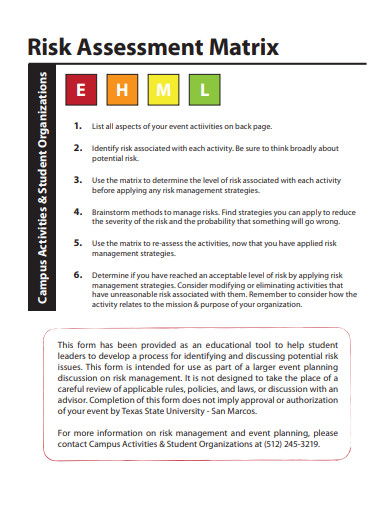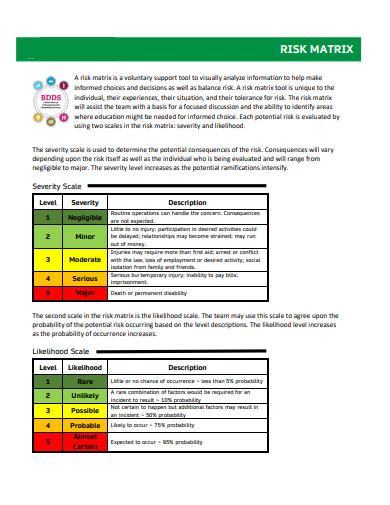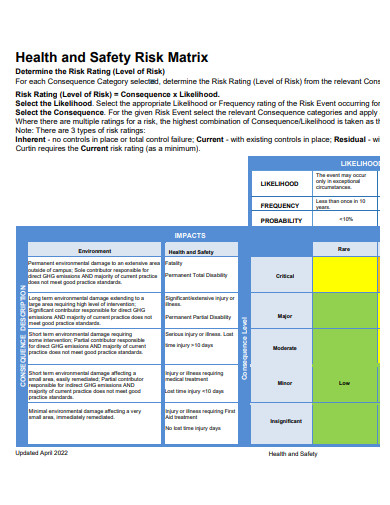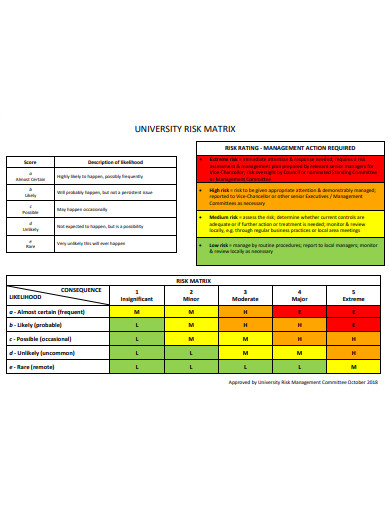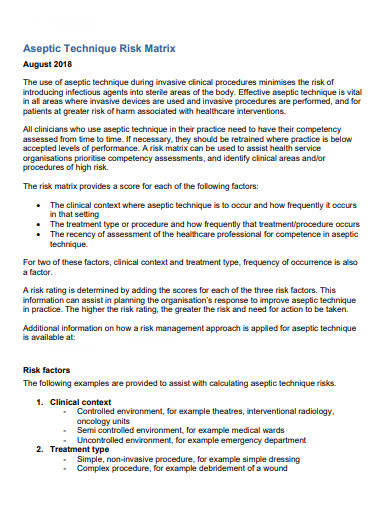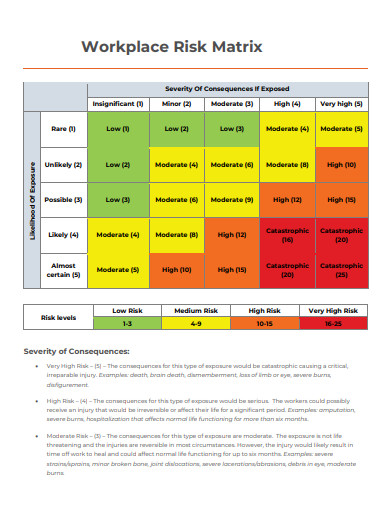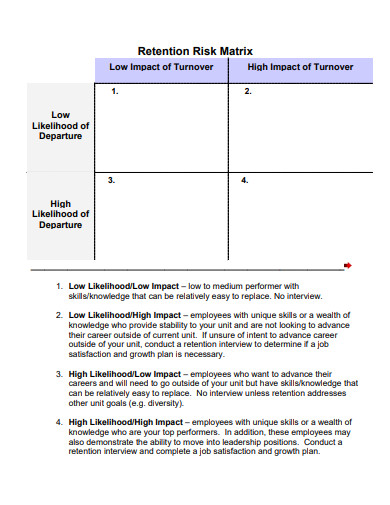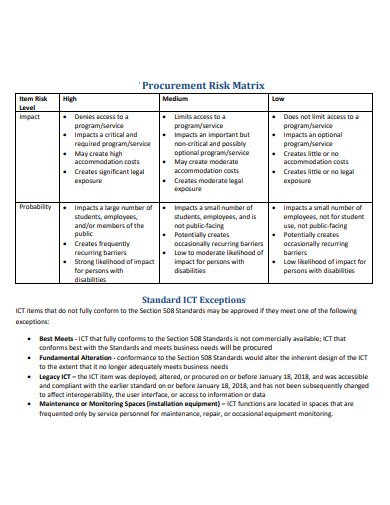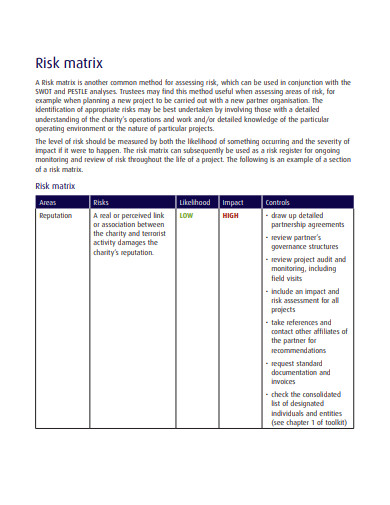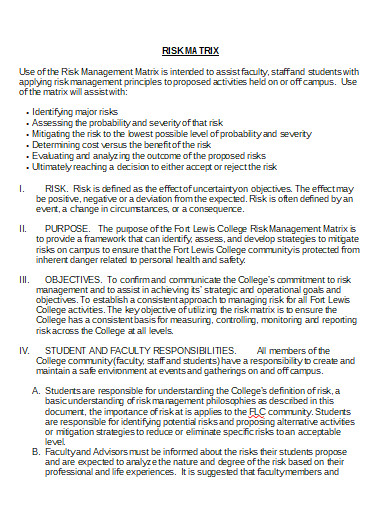Assume you’ve been appointed as the project manager for a high-stakes project. The project scope has been determined, key stakeholders have agreed, you are confident you can remain under budget, and the project team is eager to get started. A risk matrix is a simple, visual tool for determining risk levels. Although risk matrices have significant drawbacks, owing to their simplicity, they have numerous advantages. They include an accessible summary of the risks an organization faces, perhaps making it simpler to decide how hazards should be dealt with for individuals working in managing risk as well as those in high positions.
10+ Risk Matrix Samples
A risk matrix (also known as a risk diagram) is a diagram that depicts risks. The hazards are divided in the picture based on probability and their impacts or the level of harm, allowing the worst-case scenario to be assessed at a look. In this respect, the risk matrix should be viewed as the result of risk analysis and risk appraisal, and it is thus an essential element of your project and risk management.
1. Risk Matrix
2. Risk Assessment Matrix
3. Sample Risk Matrix
4. Health and Safety Risk Matrix
5. University Risk Matrix
6. Technique Risk Matrix
7. Workplace Risk Matrix
8. Retention Risk Matrix
9. Procurement Risk Matrix
10. Risk Matrix Example
11. Printable Risk Matrix
Calculating Risk in a Risk Matrix
A risk matrix is a useful component of project planning, and developing one does not have to be difficult. To calculate risk for your own project, here’s what to do.
Identify the risks related to your project
With your project team, evaluate as many hazards as possible. Consider the following factors as beginning points for your assessment process: scope creep, budgetary limits, schedule impacts, and allocation of resources. Create a risk record that includes all of the identified threats to find things simpler to construct your matrix.
Define and determine risk criteria for your project
Because no two risks or risk matrices are identical, you’ll need to collaborate with your project team and stakeholders to able to determine the set of criteria that will be used to analyze each risk you’ve determined. Note that two intersecting criteria, each with its own level, must be specified: the probability or likelihood that the risk event will occur and the intensity or impact the risk can have.
Analyze the risks you’ve identified
Following the identification and description of all potential risks, the following stage is to examine them. In your analysis, utilize your risk criteria to classify each risk according to its severity degree and probability. Using the matrix, it is then simple to multiply severity by likelihood to obtain a numerical value. A danger that is catastrophic and highly likely would be assigned a 25, whereas one that is insignificant and extremely unlikely would be assigned a one. It’s a quick and easy approach to compare and comprehend hazards.
Prioritize the risk and make an action plan
The third phase is to prioritize the risks and develop risk management measures to overcome or neutralize them, with your risks classified appropriately. You should detail the procedures you’ll take if the risk occurs, as well as the methods you’ll use to assist get the project back on track.
FAQs
What do you do with risk matrix results?
To begin, it is critical to address the risks that are rated as high or extreme. Depending on the scope of the project and the resources available to your team, you may only have to observe the medium and low-risk classifications rather than performing procedures. Finally, keep referring back to your risk matrix throughout the project until it is designated complete and successful. Don’t make the mistake of failing to commit to risk management as a continuous process. Using this tool is a fantastic approach to support your project team and alleviate any bottlenecks that stand in the way of a successful project.
What is a risk assessment matrix?
A risk assessment matrix (also known as a risk control matrix) is a tool that is used during the risk evaluation phase of project planning. It’s used to detect and capture project hazards, as well as to assess the possible harm or disruption produced by those risks.
It is reasonable to remark that the risk matrix’s simplicity is both its strongest point and its greatest flaw. Their simplicity provides a wonderful overview of risk levels, but it also implies that complexities are left out, which can have a negative impact on decision making. Consider what other measures, in addition to a risk matrix, you might put in place to ensure the robustness of your risk management process.
Related Posts
FREE 10+ Brand Story Samples in PDF | MS Word
FREE 10+ Brand Guidelines Samples in PDF | MS Word
FREE 10+ Employee Offboarding Samples in PDF | MS Word
FREE 10+ Process Documentation Samples in PDF | MS Word
FREE 3+ Introduction About Myself Samples in PDF
FREE 10+ Process Map Samples in PDF | MS Word
FREE 10+ Decision Matrix Samples in MS Word | PDF | DOC
FREE 10+ Diversity and Inclusion Statement Samples [ University, Faculty, Value ]
FREE 10+ Bid Comparison Samples in PDF | MS Word
FREE 10+ HR Records Samples in PDF | MS Word
FREE 10+ Brand Brief Samples in PDF | MS Word
FREE 10+ Merger and Acquisition Template Samples in PDF | MS Word
FREE 10+ Cost Comparison Samples in PDF | MS Word
FREE 10+ Brand Pyramid Samples in PDF
FREE 10+ Workflow Mapping Samples in PDF | MS Word


